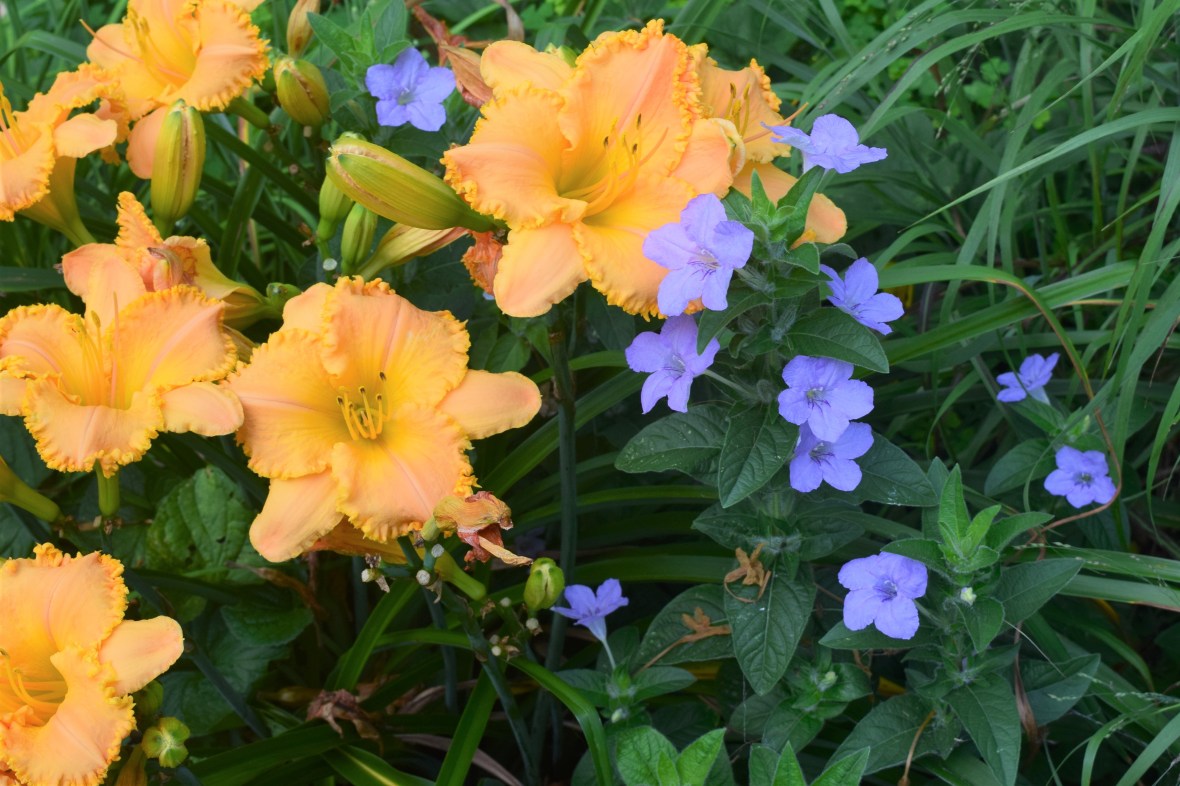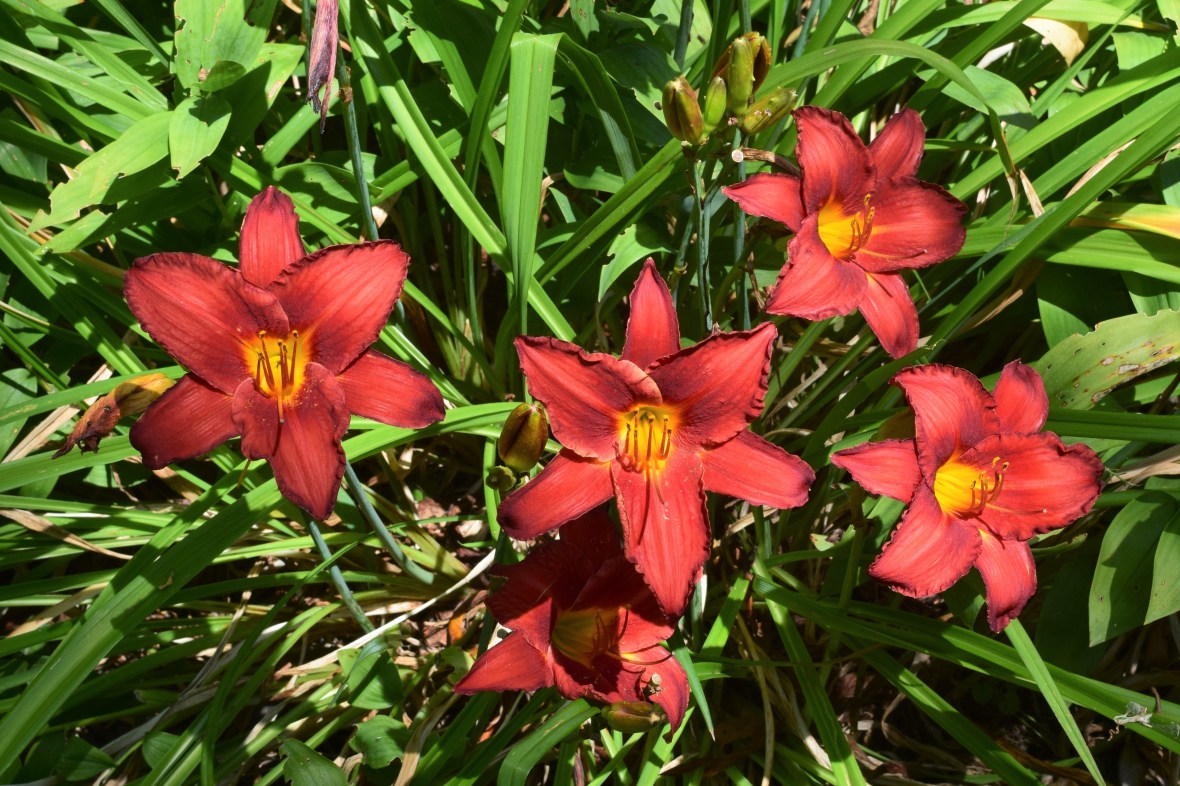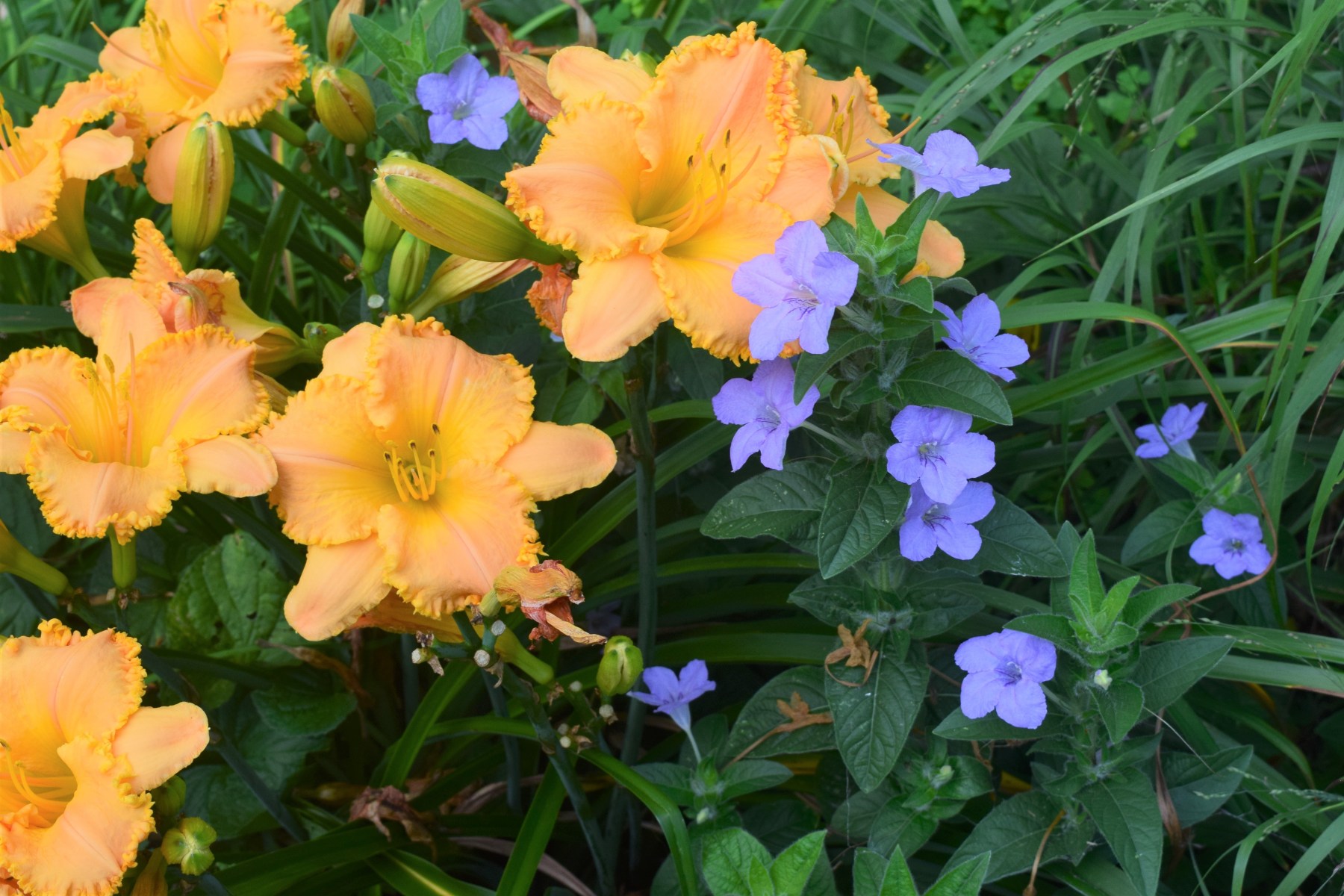I went through a Daylily (Hemerocallis sp. and cvs.) phase for a year or two, then lost interest. This says more about me than it does about Daylilies – I go through frequent periods of enthusiasm for a particular species or genus of plant. In most cases the enthusiasm fades, but leaves behind a few clumps of plants here and there in the garden. Overall, I would say that the garden is better for it.

Most of the Daylilies in our garden are tucked into out-of-the-way corners. An exception is ‘Eye-yi-yi’, which occupies a highly visible spot in the Driveway Border.

What drew me to Daylilies for a time was their extraordinary toughness, the many variations of flowers in the red-to-orange color range, and the grassy foliage. They really are carefree plants, not needing much attention except for a division every few years.

While no Daylily is native to North America, they can play nicely with a number of native plants. Above is Daylily ‘Priceless Gold Strike’ with Wild Petunia (Ruellia humilis). Wild Petunia grows 1-2′ high and has more of a mounded to sprawling habit. It fills in well around other plants in sunny spots and can tolerate dry conditions.

Like Daylilies, Wild Petunia requires no special attention and can make a nice edging for a bed or border. It emerges late, so it also combines well with spring bubs. As with Daylilies, the flowers usually last for a single day. They are attractive to native pollinators, especially long-tongued bees. Wild Petunia is also a host plant for Common Buckeye butterflies.

I’ve already written about Bush’s Poppy Mallow (Callirhoe bushii) this year, but I don’t think I mentioned that it combines nicely with Daylilies, especially yellow ones. I can’t remember this Daylily’s name, unfortunately, but I do like the soft yellow 6-pointed stars with little round pops of magenta supplied by the Poppy Mallow.

And now, a few more Daylilies. This is ‘Mary Todd’. There’s a nice clump of this variety at the east end of the Parkway Bed.

We have a bunch of ‘Chicago Apache’ on either side of the Crabapple tree in the Front Garden. The ones facing west bloom well but those facing east flower sparsely. I do wonder if the names of some flower cultivars, like those of sports teams, are due some reconsideration.

The ‘Egyptian Spice’ Daylilies that I planted years ago on the south side of the Crabapple tree have prospered and multiplied. The color reminds me of orange sherbet.
So there you have my Daylily collection, such as it is, with a couple of companions. I don’t expect I’ll be adding more Daylilies any time soon, but I don’t expect to get rid of any, either. While the infatuation is long passed, I do feel that most sunny gardens are better off with at least one or two varieties of Daylily.






I will take that “Priceless Gold Strike,” thank you. That color with that frill — and next to that blue — is outstanding.
Agreed.
I like Daylilies too because they are such low maintenance, (and colourful)…here in Canberra they will faithfully flower every year, regardless of rain, hail, snow or drought!
They are definitely reliable.
I remember longing for ‘Eye-yi-yi’ last year, and then promptly forgot about it! This time I’ll write it down.
I’m going through my daylily phase right now! Egyptian Spice is very pretty.
Eye-yi-yi is just as wonderful in person as in the photos, and I highly recommend it!
Have you seen the catalog from Oakes Daylily Nursery?
Eye-Yi-Yi certainly caught my eye. 😉
As it was meant to.
My garden would be a much sadder place in July without its day lilies, they provide so much colour for so little effort. I too had a passion for them quite a few years ago, haven’t bought any since but I wouldn’t be without them.
I’m in a similar place in regards to day lilies.
I think if you garden you do go through “spells”. I have had a daylily spell myself. I really like the ones I have but I haven’t been tempted in a long time to seek out and purchase a new one. I love it when they go through their blooming spell. I often see bugs in the blooms so they are an asset to the garden in more ways than their beautiful blooms. Yet one can only have so much strappy leaves in the garden. Your collection is very nice. I am going to remember to plant some of those petunias with mine next spring. A beautiful arrangement.
Thanks. I do think sometimes native and non-native plants can go really well together.
That is such a coincidence. I was just looking at day lilies online and put Chicago Apache on my wishlist for next year! I don‘t have any at all in the new garden yet, and have decided to remedy that. As you say, they are tough and easy to care for, and a lovely splash of colour in summer too. 😃
And they can tolerate hot and dry conditions.
Beautiful lilies!! What gorgeous summer treats!
Agreed!
I’ve always liked daylilies but I wouldn’t want too many of them. Just here and there in the garden rather than whole borders of them.
Yes, I wouldn’t want whole borders of them either.
You have some pretty ones to remind you of your infatuation, Jason!
The first daylily I ever bought was supposed to be a H. citrina, and fragrant. It is a pretty soft yellow, but not fragrant, so I suspect it was mislabeled. Then I had a crush on the spider daylilies, and bought a couple of those. One is called Watchyl Dancing. I’m also a fan of the little everblooming ones – I have a dark, dark red one. A lovely fragrant bright orange-yellow variety was given to me by a friend – I like that one a lot, too. However, none of these are great performers in my shady yard, so one by one, they are migrating to my community plot, where they seem to be comparatively thriving. Hope to see some real improvement in all of them by next summer!
Bet you’re right. Looking forward to seeing the pictures!
I think all gardeners go through phases. You’ve gathered a nice collection of Daylily. Obviously, ‘Eye-yi-yi’ is an attention grabber, but upon carful consideration I concluded ‘Priceless Gold Strike’ is even lovelier: not just for the ruffles, but the peachy tone in the center of the petals. It’s a real beauty. All around, the color combinations with other flowers is quite magnificent.
‘Priceless Gold Strike’ is from Klehm’s Song Sparrow Farm – they do a fair amount of daylily breeding.
I have a lot of daylilies, but have moved some out and others in, and I love them all. It’s hotter that hades out there and there they are smiling up at me.
Daylilies can really get prolific. We were planning to divide a humongous colony of common sorts that have spread underneath benches, but probably will not get to it this autumn will everything else that is going on.
My daylilies have not bloomed well this year. They are on the relocation list, so maybe once divided and moved, they will do better.
I really enjoyed them all. Some lovely combinations here. Gardeners certainly fall in and out of love with plants for sure!xxx
You have some beautiful daylilys–the ‘Priceless Gold Strike’ is a delicious color. Your foliage looks great, too. One called ‘Bella Rossa’ is great because it repeat blooms multiple times, and because of all the blooming, the plant never forms much of a clump–more flowers than foliage!
I have an issue with some of the names as well–there is one oldie-but-goodie which is a very goodie, but the name ‘Indian Giver’ is–uhhh…yikes!. So I call it ‘I Give’ instead. It’s not the plant’s fault.
Lovely daylilies.
Ruellia humilis is a Texas native. I’m not sure I’ve ever found it, but we have several related species, and they can be really hard to distinguish one from another, especially since they tend to hybridize easily. They certainly do look nice with your daylilies. I just learned that they’re a member of the Acanthaceae, and that they’re a host plant for the Common Buckeye butterfly.